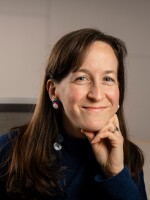School’s out and the weather’s hot, so this week, we decided to escape the heat of the valley and go to camp in the mountains. Bearskin Meadow Camp is a not-so-typical summer camp near Hume Lake, where campers do more than play outside and share campfire stories.
Lexie Watkins wants to be on Broadway when she gets older. So today, while other kids are out hiking, playing ultimate Frisbee and learning outdoor cooking, Watkins is on a small amphitheater stage surrounded by sequoias and aspens doing improv sketches. She’s in the driver’s seat of a chaotic imaginary taxi, trying to guess that her riders are Rapunzel, a Dwayne “The Rock” Johnson impersonator, and a petulant smartphone-obsessed child.

“I really can't see myself anywhere else besides the stage,” says the high school junior from Bakersfield and a regular at Bearskin Meadow. “It's my safe spot; it's my comfort zone.”
When the bell rings for lunch, high schoolers rush out of cabins and athletic fields, walking along dirt pathways sprinkled with pine needles. In almost every way, Bearskin Meadow looks, sounds and smells like any other camp in the woods—until you walk into the cafeteria.
Signs throughout the room list foods and numbers—the carbohydrate content of every ingredient in their meal. Campers can’t eat lunch until they’ve lined up with nurses and counselors to count their carbs and talk blood glucose levels. “You always rise after exercise, right?” a counselor asks Watkins. “I haven't gone low here and I would rather go low than high right now,” she responds.
Watkins has type 1 diabetes, or T1D. So does everyone else here—something Watkins says is kind of mind-blowing to her friends back home.

“They always ask: What do you do, do you just learn? Is it even fun? Do you do things? And I'm like, it's a normal summer camp,” she says. “We do archery, we have a pool, we do everything we want to do at a normal summer camp except it's just all diabetics related.”
This 10-day teen camp is one of many programs for individuals with diabetes here at this cluster of wooden cabins in Giant Sequoia National Monument. They’re all organized by the non-profit organization Diabetes Youth Families, and they aim to introduce kids with T1D to activities many thought they could never do. And while campers hail from across the state and beyond, the camp’s location in the forests of Fresno County is at the core of its identity.
In type 1 diabetes, the pancreas produces too little insulin, which normally helps cells process glucose. So, individuals with T1D need to help their body absorb sugars by calculating and administering the precise amount of insulin they need in order to function.

“It's extremely uncommon to die from hypoglycemia, but it's still a possibility,” says Maureen McGrath, lead diabetes clinician for the camp and a nursing instructor at UC San Francisco. She and the extensive medical staff help campers check their blood sugar dozens of times per day to avoid extreme high or low levels. “You can seize, you can have severe low blood sugar, so we are really taking care that this does not happen at camp,” she says.
In addition to providing round-the-clock physical medical care, McGrath says they also focus on psychological well-being. “I don't think we do such a great job of that in our clinics,” she says, “because we see them for 30 minutes to an hour, four times a year. Here we get them for 10 days, and we can really address the sadness and grief they have around their diabetes.”
The camp opened in 1938, initially at a site in Sonoma County. According to resident camp director Kaylor Glassman, after that first year, camp hosts told them not to return because they thought diabetes was contagious. “And so that’s actually then when we moved up here,” Glassman says. “We were kind of booted out of the original spot but then welcomed up here, and it's been our home.”
Glassman says campers from the San Joaquin Valley are underrepresented at Bearskin Meadow, despite how close they live. “We definitely want to see more kids coming from the Valley,” she says. “It's harder to recruit kids from the valley because it's harder to get out there since our office is in the Bay area and since we don't have as many medical centers here to work with.”

On the other hand, Glassman says, those campers who do come from the valley are more likely to receive scholarships, many of which are provided by the women’s service organization Theta Tau Theta. Group president Janet Garcia of Sanger says over the past five years, the organization’s five chapters, most of which are in the Valley, have raised over $200,000 for the camp. “There’s a need,” Garcia says, “In Hanford, Sanger, we know that there are kids that need help to go to camp.”
For Lexie Watkins, Bearskin Meadow helped her realize her limits are a lot farther than she originally thought. “I never thought I could go in high altitude, but we are in a very high altitude,” Watkins says. Now, “I know how to correct myself in areas like that for like going camping and hiking.”
Other diabetes myths? That people with T1D can’t eat sugary foods and can’t go backpacking. Both busted here.




